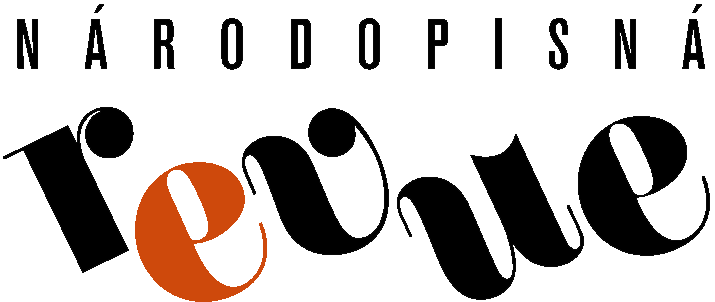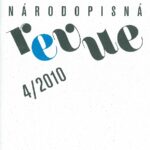Journal of Ethnology 4/2010 focuses on the dance in the gender and political context. Daniela Stavělová defines the dance antropological study in connection with some selected social aspects (Some Issues of Ethnochoreological Study: Dance, Gender, and Politics). Anca Giurchescu devotes herself to the Rumanian Pentecost ritual called căluş, its contemporary form and role it played during the period of the Communist regime (Survival of a Ritual in Contemporary Social Contexts: Căluş - between Ritual and National Symbol). Kateřina Černíčková portrays the ethnographic area of Horňácko and its sedlácká dance (The Sedlácká-Dance from the Ethnographic Area of Horňácko in Political Rhythm. A Musical and Dance Tradition in Light of Social and Political Activities from the late-19th Century until 1945). In her contribution, Tereza Nováková follows the paralell of gender relations in the society and dance (Argentine Tango: a Gender Image of the Society), Kristýna Slezáková analyses on an example of capoeiro motion activity its transformations in relation to changing political regimes in Brazil (Capoeira as a Politically Functioning Phenomenon).
Transferring Tradition column presents the theme of women´s dance expressions at the men´s dance verbuňk (by Jarmila Vrtalová) and the contribution on Baroque Christmas plays (by Ludmila Sochorová). Materials column brings the study devoted to the digital conversion of photo-documents and the ethic issues on the example of photo archive collection at the National Institute of Folk Culture in Strážnice (by Michal Škopík). Social Chronicle remembers the anniversaries of ethnologist Marta Šrámková (born 1935), cultural anthropologist Zdeněk Salzmann (born 1925) and ethnologist Milan Leščák (born 1940), and publishes two obituaries: for singer and musician Jiří Kapic (1931-2010) and ethnologist Jaroslav Štika (1931-2010). Other regular columns include the information on conferences, exhibitions, festivals, reviews of new books, and actual professional activities.
Some Issues of Ethnochoreological Study: Dance, Gender and Politics
The contribution presents a theoretical definition of the dance anthropological study aimed at the issue of gender and social and political aspects. The above is based on post-structuralist tendencies and especially on possible semiotic analysis. The comprehension of dance expression as a symbol (which can be understood only if being a part of so-called performance) and the reference to its multi-dimensionality have become a significant point of the study. Dance as a visual expression significantly contributes to the study of gender relations, especially because of the gender performativity whose essence is created by repeated and ritualized acts and gender body stylizations. There is pointed out the fact that dance disposes of unique power thanks to which it can support and change the existing social and political structure simultaneously. In this sense, there is developed the possibility to use the dance as a symbol of national identity whereby the deliberate manipulation with this symbol is an essential element. The manipulation then becomes an efficient weapon in reaching the political goals. Important remains the fact that the dance as a clearly visible (and audible) hallmark improved by the entertainment experience is - in this case - a suitable mean of expression, which can be understandable for the widest social groups within the given culture.
Survival of a ritual in contemporary social contexts: Căluş - between ritual and national symbol
Ritual căluş is a still living ritual practice at Pentecost (Whitsuntide) in the southern regions of Romania. Considered at a synchronic level, it reveals a great variety of structures and meanings that represent different stages of transformation. This article is based primarily on the long-time fieldwork experience and information resulting from the dialogues with tradition bearers, the direct observation and the analysis and interpretation of visual and written documents. The intention is to present the ritual căluş in its contemporary existence and try to disclose the reasons of its survival. Subsequently the intention is to comment the role given to căluş as a national symbol and the manipulation therewith for legitimating the political power under the Communist dictatorship. Finally, the future existence of the ritual căluş will be questioned in the light of the UNESCO program for the safeguarding of the cultural heritage. In an introductory section, however, căluş will be situated in a large European cultural context and described in more general terms in order to illuminate the complex structure of the ritual and the intricate relationship established among and between the component elements.
The sedlácká-dance from the ethnographic area of Horňácko in political rhythm. A musical and dance tradition in light of social and political activities from the late-19th century until 1945
The study describes concrete social and political activities that influenced the conditions for existence and the processes of passing down the musical and dance folklore, namely the dance called sedlácká (farmer’s dance) from the Moravian region of Horňácko. The historical probe carried out within the chosen regional and time limits, focuses on the documentation of social and political circumstances under which the expressions of traditional folk culture were applied. During the monitored period of time, the issues concerning the process of the Czech national movement and political emancipation as well as the issues related to the creation and confirmation of the feeling of Czech and Slovak mutuality come to the fore. Attention is paid to different political meetings, manifestations, festivals; the mass gymnastics displays whose main aim was to demonstrate the support and strength of the national movement could not be omitted. It was essential, however, to specify the role a concrete musical and dance expression closely connected with the local tradition played and to find out how its performance at social and political events was reflected in its following viability.
Argentine tango: a gender image of the society
The contribution features the parallel between the development in gender relations and in dance. The objective is to verify the hypothesis that the reflections of social changes in cultural phenomena become evident - in case of Argentine tango - through the transformation of traditional roles, interfering with the hitherto firm parallel: body - sex - gender - gender’s dance role - gender’s performance. In the preamble, the author introduces the phenomenon of Argentine tango and the social and anthropological background of her research, which allows analyzing the human body and its motion as a text in context. In the first part of the essay, she introduces the reader to the history, development, structure, and etiquette of Argentine tango. Essential for the essay is its closing part, an analysis of the tango gender structure and its transformations in time, analyzing the structure, performance, interference, and deconstruction of gender stereotypes and archetypes in tango. The author points out an apparent hierarchy of those concepts and their postmodern characteristics.
Capoeira as a politically functioning phenomenon
Capoeira is a Brazilian cultural phenomenon. It is a motion activity at the boundary of fight, dance and play accompanied by specific music and songs, whose outstanding feature is a unique leading musical instrument. Today, capoeira serves as a legacy of slavery because it originates in mingling of the dragged Africans´ cultures with the new environment suppressing every human liberty. The essay deals with the development of capoeira within the political relations of the country. It follows how capoeira reflects the changes of political regimes in Brazil, pointing out that the phenomenon - because of its character - entered into the political events directly, having become a bearer of certain ideas. The author comes to a conclusion that the political significance of the observed phenomenon has changed lately and capoeira is becoming rather an instrument of social mechanisms. The issue if the phenomenon is influencing the political events even today or if it can be a part of political programs remains opened, leaving room for next research.



